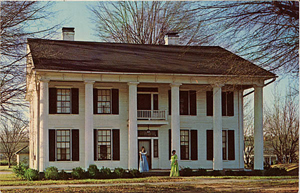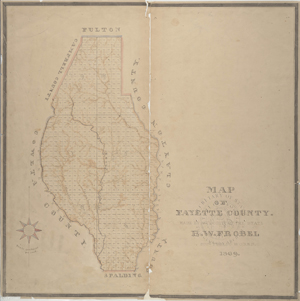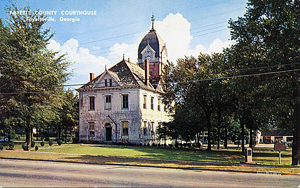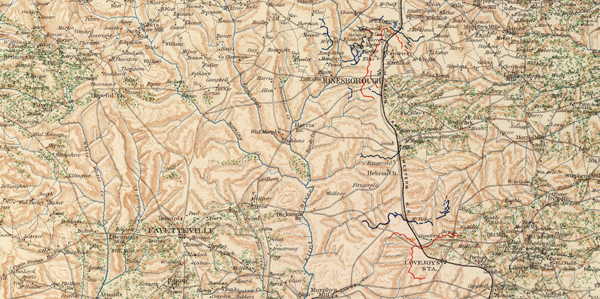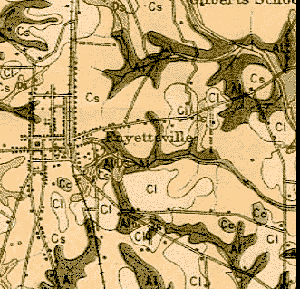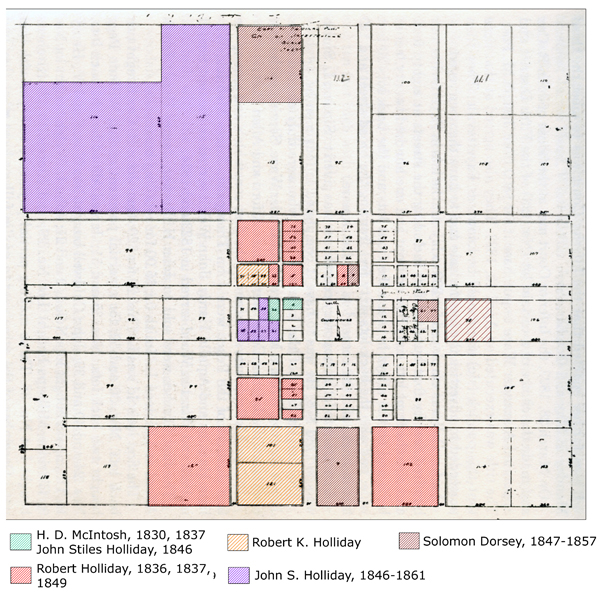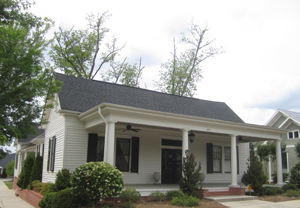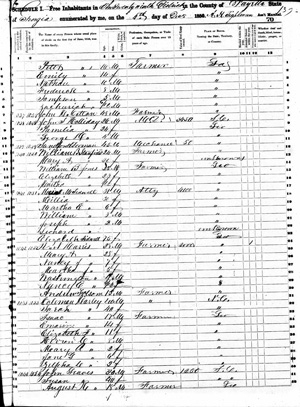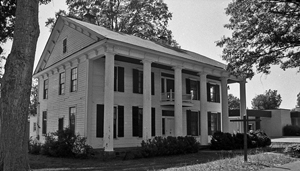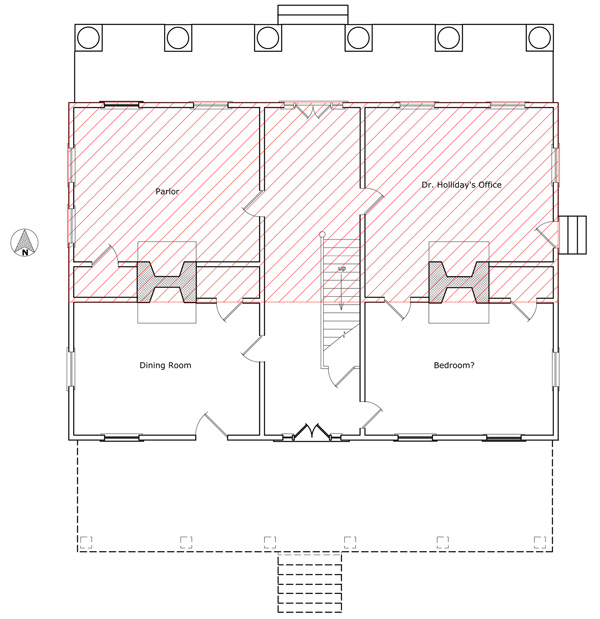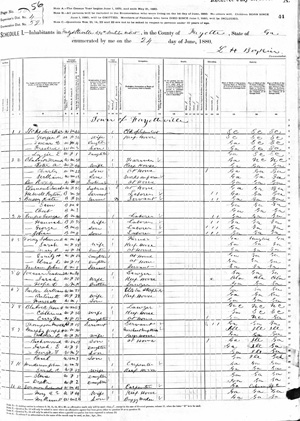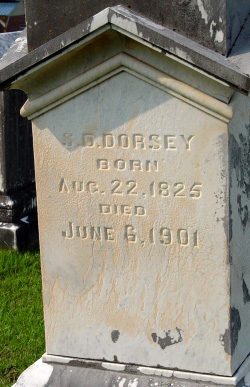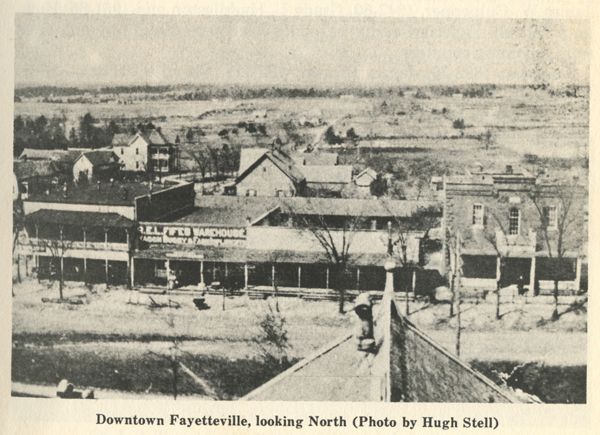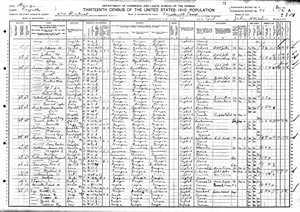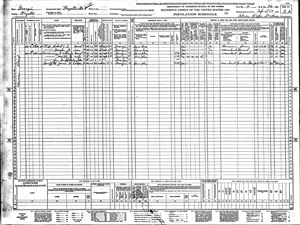Located just off the square in downtown Fayetteville, Georgia, the Holliday-Dorsey-Fife House is one of the few early-nineteenth-century structures to survive the explosive suburban growth of the area in the last quarter of the twentieth century. The house, which was constructed sometime in the second quarter of the nineteenth century and enlarged and remodeled in 1855, was probably the largest and most pretentious residence built in Fayetteville before the Civil War, and it remains a landmark in the city today. Listed in the National Register of Historic Places, the house is an excellent example of the vernacular expressions of the Greek Revival that were the closest many in the southern piedmont ever saw of high-style architecture.
Fayette County and Fayetteville
Named in honor of the Marquis de La Fayette, the great French hero of the American Revolution, Fayette County was one of five large "mother" counties created out of the lands of the Creek nation that were ceded to the State of Georgia by the first Treaty of Indian Springs in January 1821. Out of these counties were eventually organized the dozens of counties that now occupy the area. Until all Creek claims to land in Georgia were effectively extinguished in 1827, Fayette County remained part of the frontier between the Creek and the State of Georgia, which defied even the Federal government and the U. S. Supreme Court in its determination to expel the native Indian population from the state. By 1830, over 5,500 white residents were in the county, which then included what is now south Fulton County and the western half of Clayton County along with parts of other surrounding counties.
Fayetteville itself was incorporated by the State Legislature in December 1823 as the county seat and was laid out in 1824 on a plan that was centered around a courthouse square and four other squares that may have been intended for churches or other public use. Along each of the eight streets that radiated off the courthouse square, small commercial "front" lots were laid out, with larger house lots laid out around this central core. Of the commercial lots, only the front lots facing the courthouse square on the north, west and south were ever really developed as planned. Along the east side of the courthouse square, for instance, the four front lots were occupied by a single residence until construction of the Methodist Church in recent years. The Holliday House site itself was originally composed of eight of these original commercial lots.
Four main roads entered the town: to the south, the Zebulon road, now Lee Street; to the east, the McDonough road, now South Jeff Davis; to the east and northeast, the Decatur road, now Ga. Hwy. 54 east; to the north and northwest, the Carrollton road, now Ga. Hwy 85/92 north; and to the west and southwest, the Newnan road, now Stonewall Avenue. Travel during the earliest period was especially arduous—the closest stagecoach line was twenty miles away at McDonough in the 1820s—but there were no paved roads in the county until 1938. Several nineteenth-century travel journals have survived and, though not mentioning Fayette County specifically, give good indication of the conditions faced by most Georgians outside the more long settled sections of eastern Georgia. Basil Hall, an Englishman traveling through the state by stagecoach in 1828, noted soon after leaving the vicinity of Savannah:
If required to give the localities with any precision in such a route, it would have been necessary to carry sextants and chronometers in the carriage. For we were fast sinking into the wild and little known parts of the continent, on which the traces of man were as yet but feebly impressed.1]
Fayette County was two hundred miles deeper still into that wilderness.
The Fayette County courthouse, built in 1825, must have been an enormously impressive building to early settlers, even without its c. 1880 clock tower or whether or not LaFayette himself actually stopped through to lay its cornerstone when he made his triumphal tour of the state in 1825. The earliest of the Georgia gazetteers to reference Fayette County is Adiel Sherwood's Gazetteer of 1827 in which he noted that the county had a population of 2,588 and that Fayetteville had a courthouse, a jail, and "42 houses, stores, offices, etc."[2] He also noted that the town was "a healthy place and rising in importance." In his second gazetteer, in 1837, Sherwood states that there were by then "50 houses and stores, etc." and, again, that the town was "rising in importance."[3]
George White's Statistics of Georgia, published in 1849 using statistics gathered in 1845, had this to say about the place:
Fayetteville, the seat of justice, is a pretty town in the centre of the county. The courthouse is a very substantial and neat brick building . . . . There are two churches, two good schools, three stores, five groceries and several mechanics' shops along with a Masonic Lodge, a printing office and one Division of the Sons of Temperance. . . . The subject of education does not engage the attention of the people as much as it ought, although there are indications of a greater interest than formerly. S. R. Minor, now living, is 90, and editor of the Fayetteville Advertisor [sic]; says he owns the original type of Dr. [Benjamin] Franklin.[4]
Figure 4. Postcard view of the Fayette County courthouse (1825-1832), c. 1960, prior to its remodeling into a three-story building. The clock tower was added in the 1880s. (Vanishing Georgia Collection) |
Fayette County experienced a tremendous period of growth in the 1840s with its population increasing over 40% to over 8,700 in 1850. This influx of people, which often included siblings and cousins and other members of an extended family migrating together, continued the impulse that had brought many of the first settlers, like the Hollidays and the Dorseys, from the Carolinas and Virginia into east Georgia after the Revolution and on to Henry and Fayette counties by the 1820s and 1830s. This growth in Fayette County was not to last, however, since many of these residents were only passing through to the new cotton lands that were being opened up farther west. Carroll County, for instance, west of the Chattahoochee, grew even faster than Fayette, nearly doubling its population in the decade of the 1840s. Many Fayette County families saw sons and daughters moving into Alabama, Mississippi and Texas, particularly after the end of the Indian Wars of the 1830s and the Mexican War in 1846-1848, as pioneers scrabbled for a part of what seemed to be a never-ending American frontier.
Part of the Piedmont "upcountry" of Georgia, Fayette County in the nineteenth century was characterized by mostly small farmers who had staked their claim and settled down to farm their one or two hundred acres with the help of a large family and a mule or two. There were very few large plantations in the area and few of these had big houses with the sort of refined architectural character that one might have found in some of the larger, richer plantations of east or southwest Georgia.
In addition, ownership of large numbers of slaves was not a common sight in Fayette County or any of the other counties of the upper Piedmont. Three-fourths of the county's heads of household in 1850 owned no slaves at all and, of those that did, most had only one or two; a very few had more than ten. In 1850, only fifteen Fayette County residents had more than twenty-four slaves and only three of those had more than forty, with forty-eight the largest number recorded that year.
The reality of antebellum Fayette County little resembled the myth and romance of the "Old South" and the "Lost Cause" which overflows Hollywood's 1939 rendition of Margaret Mitchell's Gone With the Wind. Mitchell herself recognized the difference between these myths and reality and wrote her novel accordingly, a fact almost completely obscured by the power of the images of the silver screen. An avid researcher, she documented various aspects of antebellum life in writing her book and took great pains to portray the variety of people and ways of life that characterized the upper Piedmont. In 1938, she and the noted Atlanta historian Wilbur Kurtz documented a number of antebellum structures in Clayton County in a vain attempt to prevent Hollywood's aggrandizement of the region's antebellum life and architecture. R. E. L. Fife's grandson Robert remembered that she had visited the Holliday-Dorsey-Fife House but did not remember when. Perhaps it was as a part of Kurtz' hurried survey of antebellum architecture in preparation for filming GWTW, which commenced in December 1938.
All of that was fiction, but the skirmishing that occurred in the county during the summer of 1864 was a major event in most people's lives. Confederate wagon trains were destroyed by Union troops as the Union army continued its encirclement of Atlanta leading up to the Battle of Jonesboro, which was fought 29 August-1 September 1864. The Confederate defeat there sent rebel troops back through Fayetteville on their way to Palmetto, and there was minor skirmishing near Ebenezar Church, southwest of Fayetteville, that attracted widespread local attention. With that, the Confederate army withdrew, and Atlanta was surrendered and occupied the next day.
Life was extraordinarily hard in the years immediately after the Civil War, especially all around Atlanta. Though Fayette County had escaped the widespread destruction that characterized much of the countryside north and east of Atlanta, it did not escape plundering by both armies hungry for food, grain and livestock. For many in Fayette County and elsewhere around Atlanta, the battling armies left little for those unfortunate enough to live in the area.
Wiped out in 1864 and 1865, the agricultural economy of the region recovered only slowly after the war, with the larger landowners gradually replacing slavery with tenancy and sharecropping and the small farmers, which were most of the rest, trying to keep ahead of their debts to the merchants who sold them seed, fertilizer and tools on credit against the next cotton crop. As merchants, the Hollidays before the Civil War, the Dorseys in the late nineteenth century, and the Fifes in the twentieth century, were better able than most to survive, if not actually prosper when the economy was bad.
The mostly rural, agricultural population of the county continued to increase steadily throughout the nineteenth and early twentieth centuries, but Fayetteville's growth as a retail and commercial center was severely hampered by its inability to capitalize on the enormous growth of railroads during the period. The Macon & Western Railroad, which was built through what was then the northeast corner of the county in 1845, attracted significant growth to Rough and Ready (later Mountain View), Jonesboro and Lovejoy. As a result, in 1858, a new county, named Clayton, was created out of a large part of eastern Fayette County and western Henry County with the Macon & Western forming the spine of the new county.
The lack of growth in Fayetteville, even in the years immediately preceding the Civil War, must have been a topic of conversation when Adiel Sherwood described the town in his Gazetteer of 1860. A staunch advocate of education, he wrote,
Since the people have patronized and built up good schools here of a high grade, the town has been growing: no inland town will increase much without the aid of schools, and no people need to wonder or complain that their place is small [emphasis in original], if they fail to nurture and encourage schools.
He went on to say that "Mr. Looney has a celebrated Academy here . . .; he has written a good arithmetic and publishes a weekly paper." Sherwood was also happy to note that there was "[n]ot a place to retail liquours in the county."[5]
Figure 6. Detail from 1919 map of Georgia showing route of Atlanta and Florida Railroad through Fayetteville. The railroad was abandoned shortly before World War II. (http://railga.com/atlandfla.html) |
With its fortunes left to rise and fall with those of the agricultural economy, Fayetteville remained very much a small town throughout the nineteenth and much of the twentieth century, even during the few decades when it had railroad service. The new Atlanta and Florida Railroad would not be completed until the following year, but the first passenger train arrived in Fayetteville from Atlanta on 28 December 1887. That event and a strong cotton economy, at least until World War I, sparked a round of growth that the county had not seen since the 1850s.
Like most small towns of the region, Fayetteville experienced small spurts of growth with the waxing and waning of the railroads and the vagaries of King Cotton. In between were the periods of economic depression and bankruptcy precipitated by the destruction of the Civil War, the farm crisis in the 1870s and 1880s, and the arrival of the boll weevil during World War I. The collapse of the cotton economy in 1920 broke Fayette County, resulting in the loss of nearly one-quarter of the county's population between 1920 and 1930, and the population continued to decline into the 1950s. Not until the booming suburbanization of the 1970s did Fayette County's population again reach the 11,396 recorded in the Federal census of 1920.
Woven through the larger patterns of Fayette County's history are the smaller patterns generated by the families and individuals who settled the county and built the town in the decades before the Civil War. Four families—McIntosh, Holliday, Dorsey, and Fife—provide a context for the house and its architecture.
Hezekiah Dell McIntosh (1811-1874) was one of those characters who left but a faint imprint on the county's history. The surname is, of course, a famous one in Georgia, harking back to the great Revolutionary War patriot Gen. Lachland McIntosh and his distant relation William McIntosh (Tustunugee Hutkee), the Scots-Creek chief of the Lower Creeks. It was this William McIntosh who was murdered at his home in Whitesburg in lower Carroll County for his part in the notorious second Treaty of Indian Springs in 1825. Declared invalid, it was renegotiated but still moved the Georgia frontier beyond its then limits at Line Creek on the western edge of Fayette County to the Chattahoochee and beyond. And it was the chief's first cousin George M. Troup who, as governor, fought the Federal government so vociferously for the Cherokee removal.
The McIntoshes that begin to appear in Fayette County public records in the 1820s appear to have been unrelated to those, more-famous McIntoshes, who were descendants of the colony of Scots that settled Darien, Georgia, in the 1730s. Jesse D. McIntosh was the first McIntosh documented in Fayette County. His marriage to Margaret A. L. Head in 1829 is recorded, and he was enumerated in the 1830 Federal census with what were apparently his wife, a young daughter, and a slave. He is the only McIntosh listed in the county in that year's census. That same year, 1830, however, Hezekiah Dell McIntosh (1811-1874), Jesse's brother, bought town lot #22 from Henry B. Thompson of Warren County and, in 1837, front lot #4.6 [See Figure 7] The following fall he married Evaline Fernander (1820-1860), another of the myriad of virtually unknown names that dot the records of antebellum Fayette County. In 1838, H. D. McIntosh was appointed guardian for the four "minor orphans" of his father, also named Jesse, and apparently assisted his widowed mother in raising the children. Two of these were Marcellus and Alonzo McIntosh, whose names appear in several county records including the probate of Jesse's estate. The Fernanders, too, appear in records of the period, including the 1850 census when S.L. Fernander is listed in residence next door to Robert Holliday.
Where the McIntoshes lived is not known for certain, but most likely they lived in a house on lot #22 since no other land purchases besides front lot #4, where Hezekiah McIntosh operated a store, have been recorded. The 1830 deed states that Lot #22, located directly to the east of the Holliday-Dorsey-Fife House, was "60 feet in front and 117' back to the lower end of the mule house," meaning there was already a mule house on the property and suggesting perhaps that there might have already been a residence on the lot as well.
In 1840, McIntosh appears to have mortgaged his property, and perhaps his mother's country property as well, to William Fernander, who was probably his wife's brother. In 1846, Fernander brought a fi fa action against McIntosh and the entire estate was auctioned to John Stiles Holliday for $300. Around 1853, the McIntoshes moved to Lafayette, Mississippi, where she died in 1860, leaving him with several small children, one not yet a year old. He died in 1874 in Hill County, Texas.
John Stiles Holliday was born in Laurens County, South Carolina, in 1818, the son of Robert Alexander Holliday (1787-1862) and his wife, Rebecca Burroughs (1800-1856). The Hollidays, including young John, moved to Georgia around 1830, if not before, perhaps to Wilkes County where they may have had relatives. Robert Holliday has not been located in the 1830 census, but he was certainly in Fayette County by 1832 and 1833, when he bought four contiguous land lots northwest of present-day Harp's Crossing on Georgia 85 south of the city.7 In 1836, Robert Holliday began acquiring town lots in Fayetteville, including those at the northwest corner of the intersection of present-day Lanier Avenue and Glynn Street where he opened a hotel and sometime tavern in 1837. One of the photographs taken by Hugh Stell from the roof of the courthouse tower in the early twentieth century shows a two-story frame building on that corner which was probably Holliday's hotel. It must have been demolished shortly thereafter as it does not appear on the Sanborn map of 1923.8
In March 1839, Robert and Rebecca Holliday had the last of their eleven children, but had already lost five of the youngest at an early age, including three within one week in May of 1834, probably to cholera, dysentery, pneumonia or one of a host of other diseases that kept infant mortality appallingly high for all classes of people through most of the nineteenth century. In addition to the six children who lived, the extended Holliday family in the 1840s included Rebecca's mother, Amy Stiles Burroughs (1777-1852) and, according to one account, Robert's mother, Jane Cooper Holliday, as well. She was born in Scotland in the mid-eighteenth century but was in upstate South Carolina before or shortly after the Revolution. Her husband died in 1826, and his widow is reported to have come to Georgia in 1830 to live with their son. Jane Cooper Holliday is said to have lived to be 100, although the dates of her birth and death are not known nor is the location of her burial.
In November 1840, the Holliday's eldest daughter Martha (1824-1894) married James F. Johnson (1817-1871), attorney, merchant, and planter who would soon serve as state senator from Fayette County. In 1858, Johnson introduced the legislation which created Clayton County, and in 1859, the bill which incorporated the town of Jonesboro.The couple moved to Jonesboro in the early 1850s, and Johnson was elected state senator from Clayton County when it was formed in 1858. Johnson was also a member of the Secession Convention of 1861 that took Georgia out of the Union. In the mid-1850s, the Johnsons enlarged an older house, and they, too, remodeled it by the addition of a Greek-Revival which survived use as a hospital in 1864 and is a landmark in downtown Jonesboro today.[9]
The eldest of Robert Holliday's children was Henry Burroughs Holliday (1819-1893), named for his maternal grandfather. After fighting in the Creek and Seminole wars of the 1830s, Henry was caught up in the anti-Mexican fever of the 1840s, volunteered and fought in the Mexican War of 1845-1846. He later returned to Fayette County and married Alice Jane McKey in 1849.[10] The family soon moved to Griffin and, by 1863, to Valdosta. Their only son, John Henry "Doc" Holliday (1852-1887), was the dentist who in 1881 gained notoriety with Wyatt Earp at the OK Corral.
Figure 8. View of the Stone-Holliday House, which Robert Holliday bought in 1857. The porch, window sash, and other alterations to the rear of the house date to the early twentieth century. (Photo by author, 2012)
Figure 9. Robert Holliday's grave marker at Fayetteville City Cemetery. (Rhondajo at www.findagrave.com) |
William Cooper Holliday(1820-1868), Robert and Rebecca's second son, married Jane Holcomb in Fayette County in 1842 and settled down to life as a merchant until his untimely death shortly after the Civil War. Robert Kennedy Holliday (1829-1872), Robert and Rebecca's fourth child, married in 1848, perhaps in Atlanta, before moving to Jonesboro where, as his father had in Fayetteville, he operated a hotel in that booming town. The youngest of the Holliday's children, Rebecca Ann Eliza (1839-1911) married Joseph H. Jones in 1858 and, after his death in the Civil War, Alpheus McCoin. She died in Powatomie County, Kansas.[11]
Robert Holliday probably continued to operate his hotel and tavern into the 1850s. His mother-in-law, Amy Stiles Burroughs, died in 1852 and his wife, Rebecca, in 1856. Probably as a result of that and his advancing years, in 1857, he bought A. W. Stone's old house on town lot #121 and moved from his old residence, which was probably at or next to his hotel and across the street from his son John's house. The old Stone-Holliday House is still standing, much enlarged and remodeled, on the west side of Glynn Street just north of Beauregard Road. Now used commercially, it is one of Fayetteville's oldest buildings.
In 1859, the sale of liquor was prohibited in the county, except to physicians, who could buy it "for medical purposes" in any quantity, and it may have been at that point that Robert Holliday finally retired.[12] He apparently remained a significant character in the community until the end of his life. When the Civil War broke out and there was a mad rush to volunteer the Atlanta Intelligencer reported of Fayette County:
[N]o county in Georgia can boast of more patriotic men in proportion to numbers. They are all ready for the fight, and when other companies shall go out to battle from that county we should not be surprised to see Uncle Bob Holliday in the ranks, if his friends would permit him to go. He is of a fighting stock and no mistake, as his boys have long since proven.[13]
Robert Holliday died the next year, 1862, and was buried next to his wife in the Fayetteville City Cemetery.
John Stiles and Permelia Ware Holliday
Robert and Rebecca Holliday's third son was born in Laurens County, South Carolina, in 1818 and was only twelve when he moved with his family to Fayette County. He appears first in the county records with his marriage to Permelia Ware (1825-1894) on 27 March 1844. She may have been related to Alexander Ware, who purchased Land Lot 123 for the purpose of laying out Fayetteville and who served as the county's first state representative in 1822. Her father was George Washington Ware, who was also elected to the state legislature from Fayette County in 1839. He died in 1849 and, two years later, his son George W. Ware Jr. and John Stiles Holliday bought a grist and saw mill between Fayetteville and Bennett's Mill, which probably began the partnership of Holliday and Ware, one of the town's several mercantile establishments and the largest in 1860.[14]
John Stiles and Permelia Ware Holliday's first child, Ellen, was born almost exactly nine months after their marriage in March 1844 but died in May 1846, a few months before her second birthday. A second child, George Henry, was born in September of 1846, followed by Robert Alexander in 1850 and John Stiles Jr. in 1857, all of whom grew to adulthood.
Shortly after their marriage, John and Permelia Holliday moved to Augusta where Holliday was studying medicine at the Medical College of Georgia. After receiving his degree in 1845, they returned to Fayetteville. Quite possibly, they lived with his father or, perhaps, some of her family during this period, but they must not have done so for long. In January 1846, he made his first recorded purchase of property in Fayette County when he bought town lots #4 and #22 at a sheriff's auction of the estate of Hezekiah McIntosh. These lots were the first of eight that Holliday would eventually assemble into the historic block that would be the site of the Holliday-Dorsey-Fife House.
In 1846, the deed to John Stiles Holliday for town lot #22 and front lot #4 stated that #22 included "all the improvements thereon" and that both came "together with all the Estate, right, title, interest, property, claim and remnants of the said Hezekiah D. McIntosh."[15] Until the 1960s, these lots were purchased together each time the property changed. Although it is not certain that there was already a building on the property, the term "improvements" most usually indicates the presence of a dwelling or other substantial building. The next year, 1847, Holliday bought town lot #38 immediately to the west of #22. Purchase price for this lot, which is the site of the Holliday-Dorsey-Fife House, was $80 and, since there is also no mention of improvements, it is assumed that the lot was vacant at that time.
The generally accepted date for construction of the Holliday House has been given as 1855, although it is only Governor Dorsey's memoir of the house from 1937 that provides the earliest reference for that date. That Holliday is responsible for the house we see today is not questioned, especially since the Dorseys, who bought the house in 1871, always gave credit for the house to Holliday. While that much is clear, physical investigation of the house confirms that the Greek Revival house that we see today is actually the result of a large antebellum addition to and remodeling of an earlier house.
As suggested above, McIntosh could have built a house on lot #22 in the 1830s, and it and the mule shed mentioned in the boundary description were there when Holliday bought the property. If so, perhaps Holliday occupied the old McIntosh house for a few years and then relocated it to lot #38, which was more nearly the center of the whole block that he assembled, and enlarged it a few years later. It is also possible that Holliday simply built a new house on lot #38 as a newlywed in the mid-1840s and enlarged and remodeled that house in the middle 1850s as he became more prosperous. With existing information, all that can be said with any degree of certainty is that the present configuration of the Holliday-Dorsey-Fife House is the result of two antebellum building campaigns that, by 1857, had created the historic structure we know today.
Figure 12. Probable floor plan as the house was remodeled by Dr. Holliday in 1855. The red hatching represents the original house that remains a part of the present building. Whatever addition that existed at the rear of the original house was lost in 1855. The dashed lines represent what was probably a porch across the rear of the remodeled house. (Drawing by author) |
According to Governor Dorsey's memoir, Holliday lent his newly remodeled house as a residence for the teachers and/or students at the Fayette Academy for two years, and he did not occupy the residence until 1857. No primary documentation for that story has been located, and further research into the confusion of the various antebellum "academies" and "seminaries" in Fayetteville would be helpful. The History of Fayette County indicates that the academy building was under construction in 1856 and that Holliday was a trustee and/or on the building committee for the academy. The Academy apparently opened with the hiring of Morgan H. Looney in January 1857, and presumably the Hollidays took over the house shortly after that.[16] At the same time, it seems unlikely that the Hollidays would have vacated their house and his place of business, if he were still practicing medicine, for such an extended period of time. The remodeling of the house would certainly have taken the better part of a year and, with the supposed two years of Academy use, one wonders where the Hollidays lived.
John and Permelia's fourth and last child, John Stiles Holliday Jr., was born in February of 1857; in August, he bought the four lots behind and south of the lots he already owned on the north side of the block. Although the increase in the valuation of Holliday's "town property" from $1000 in 1857 to $2500 in 1858 may be partly due to Holliday's remodeling of the house, it was also due in part to his purchase of these lots.
Fronting on the old Newnan Road, now Stonewall Avenue, the lots acquired in 1857—#21, #37, #53 and #69—were bought from Holliday's next-door neighbor William Bennett (1791-1873).[17] Although the deed has not been located, Holliday probably also bought the remaining two lots on the block, #54 and #79, during this period, probably also from Bennett who was one of the county's early settlers, a major landowner, and the namesake for Bennett's Mill. His house, which is still standing just west of these lots, appears to have had an evolutionary history similar to that of the Holliday house.
Holliday's block of lots consisted of just over an acre and a half of land and allowed him ample room for the vegetable garden, fruit trees, milk cows and chickens that were common even for the well-to-do living in town. A smoke house is known to have existed on the property as well, another indication that the Hollidays, like most other people of the period, relied on the produce from their own gardens and livestock to feed their families. Most of the early houses in Fayetteville and elsewhere were built on large lots in order to accommodate just these sorts of activities.[18]
Son of one of Fayetteville’s earliest and most-prominent residents, John Stiles Holliday was not a typical citizen of Fayetteville but rather a doctor, which gained him instant respect. He was also a slave-holder, which also set him apart from the large majority of Southerners who were not. In 1850, the census showed him owning six slaves, the oldest an eighteen-year-old female, who may have been their cook, and the rest children ranging from one to eleven years of age. By 1860, he could claim ownership of thirteen slaves, which included a 35-year-old male, two females in their 20s, and two teen-aged boys. The remainder were children, including six-month-old twins. Where these people lived is not documented, but it is unlikely that there were any live-in house servants for the Hollidays in Fayetteville.
Holliday also formed a partnership with George W. Ware, his wife's brother or nephew, as early as 1851 when they bought a grist and saw mill on the west side of town. By 1860, the firm of Holliday and Ware had Fayetteville’s largest mercantile store, selling, among other things, furniture.[19] How active Holliday was in the actual operation of these businesses is not known; he might have been only an investment partner with the younger Ware, but that is not likely.
In addition, Holliday acquired deed to, or at least held a mortgage on, significant acreage in the county, including two or three land lots near Ebenezar Church. The fact that he is listed with thirteen slaves in 1860 indicates that he was probably farming at least some of his country property. Nevertheless, several of these slaves probably lived in a servants' house on Holliday's town property to help Permelia run the house and to keep what amounted to, from today's perspective, a small farm operation going on that property.
With his office reported to have been located in the northeast room on the first floor of the house and Holliday and Ware located directly across the alley on front lot #2, Holliday could never be far from his work, a real advantage in those days when feet remained the predominant mode of local transportation. As a doctor, however, he kept a buggy and/or carriage, most likely to make the house calls that would have been numerous in those days as well.[20]
Although John Holliday was a member of the "Fayette Dragoons," it is not known if he actually saw fighting during the Civil War. Local tradition holds that Permelia Holliday was among the group of four women who sewed the flag of the county's first volunteer company, "the Fayette Rifle Greys," in 1861.[21] According to traditionally as well, the Holliday House was used to house Confederate prisoners after McCook's raid in 1864. One wonders about the Hollidays' whereabouts during this period, except that of John and Permelia Holliday's eldest son, George Henry Holliday, who was listed as a cadet at the military institute in Marietta in the state's "Joe Brown" census in early 1864.
Figure 14. Robert Kennedy Holliday (1829-1972), brother of John Stiles Holliday, c. 1865. (Vanishing Georgia Collection) |
It is believed that Holliday was a surgeon for the Home Guard and, therefore, probably remained in Fayetteville during the early years of the war. He certainly was in Fayetteville to settle his father's estate in 1863. In February of that year, he sold his father's house on lot #121 to J. W. Camp and, in August, the two hundred acre land lot near present-day Georgia Highways 314 and 85 that his father had bought in the 1830s to another of his neighbors, Solomon Dorsey.
With the fall of Vicksburg in July 1863, Grant and Sherman began to develop their plan to divide the South with a great "march to the sea" and, by the end of the year, the Atlanta hospitals were beginning to fill with the wounded from the battles that ripped the Tennessee Valley in 1863 and 1864. It is thought that Holliday was called to Atlanta during this period and, like Margaret Mitchell's character Dr. Meade, spent some of the most exhausting months of his career in the city’s hospitals.
With the end of the war, Holliday may have returned to Fayetteville although it appears that he did not but, rather, is thought to have rented the house to Emily Ware, who may have been Permelia Ware’s niece, and her husband, Fayetteville attorney William B. Fuller. Holliday continued to be taxed for his Fayetteville property until he sold it in 1867, but he is thought to have already moved to Atlanta at that time. Atlanta boomed after the war, rising from the ashes of 1864 to be made the State capital barely four years later; Holliday would no doubt have seen the potential for his own career in that environment.
In addition, professional men such as Holliday would have had an especially difficult time coping with the hard times immediately after the war, especially in a small town like Fayetteville. Without slaves, who were probably responsible for maintenance of the kitchen garden that would have supplied much of the food for the family, and in the middle of a part of the state that had been stripped absolutely bare of all food supplies by the two competing armies in 1864, simple survival would have been a problem for everyone, including the Hollidays, in 1865. Conditions would improve only slowly after that as the state struggled through post-war reconstruction.
Whatever his reasons, in March 1867, Holliday sold the house to his mother-in-law, Mildred Ware, for $1500. The deed included "part of #4" and the eight lots behind "encompassing all that land enclosed by fencing and known in the village as J. S. Holliday's town property."[22]He eventually acquired a house at the corner of Piedmont Avenue and Ralph McGill Boulevard where he and his wife lived out their lives. They are both buried at Westview Cemetery in Atlanta.
Although the deed has not been located and may never have been recorded, Mildred Ware is thought to have sold the property in 1871 to Solomon Dorsey (1825-1901.23 The son of John Dorsey (1780-1870) and Mary Phillips (1791-1851), Solomon Dorsey was born about the time his parents moved from Jones County to Henry County, where they settled near present-day Lovejoy and raised their eight children. All raised in Henry County, the Dorsey children left a considerable mark on the history and the architecture of the area. Daughter Althea (1816-1892) married Thomas Shanklin Crawford (1806-1894), son of William Crawford (1778-1841) and one of the largest planters in the area. In 1835, they built a house just west of Lovejoy that they remodeled and enlarged considerably about 1850. It was one of the few antebellum houses in the area that had any pretensions to the classic, columned Greek-Revival mansion of myth and lore. Known today as the Crawford-Talmadge house, it was long the home of the late Betty S. Talmadge and her husband, Herman Talmadge.
|
Figure 15. Part of 1880 Federal Census schedule, showing Solomon D. Dorsey.
Figure 16 View of Solomon Dorsey's grave marker at Fayetteville City Cemetery. (findagrave.com) |
John's son Stephen Green Dorsey (1822-1915) also left the area an important legacy when he bought the plantation-plain style house that William Crawford had built in the 1820s just north of Lovejoy. Traditionally said to have been a stop on the stagecoach route between McDonough and Fayetteville, the house was considerably enlarged by Stephen Dorsey in 1858, reportedly by rolling another house to the site and attaching it to the old Crawford house. Four, slender, two-story columns supported a gabled portico in the "new" house, which is believed to have been done by the same builder who created the Crawford-Talmadge house a few years before and who would complete James and Martha Holliday Johnson's remodeling of their new home in Jonesboro in 1859.24 The William Crawford-Stephen Dorsey house has been lost to vandalism and neglect, but the Crawford-Talmadge house at Lovejoy, the Johnson-Blalock house at Jonesboro, and the Holliday-Dorsey-Fife House at Fayetteville remain as three of the area's most important historic and architectural landmarks.
Solomon Dorsey grew up in the long-vanished plain-style house that his father built in the 1820s, which stood not far from the likewise now-vanished home of William Crawford just north of what would become Lovejoy Station. Educated in McDonough, he married early, at the age of 18, in December 1842 to Sarah Glass, daughter of another early Henry County pioneer Manson Glass. The following year they moved to Fayette County, where he had already bought property the preceding year and where their first child was born in 1843. By the 1850s, he was living in or near Fayetteville, probably on the north side of town and would have been a near neighbor of John Holliday. He owned several lots in town, including what would later become the site of the county jail. He had also become one of the town's leading citizens, serving as a trustee for the Fayetteville Seminary before the Civil War and as the town's second mayor after that office was created about 1870. He was also a large landowner in the area and owned a significant number of slaves: seventeen are recorded in 1850 and twenty-two in 1860. A trustee of the Methodist Episcopal Church South, Solomon Dorsey was also a veteran of the Confederate Army of Tennessee, where he attained the rank of lieutenant but was later always addressed with the polite title of "colonel" in recognition of his rank in the Georgia Militia.[25]
In March 1870, Solomon Dorsey's father died, followed by his stepmother in October. In between, in May, his second-eldest son, Rufus Thomas (1848-1909), became the first of his children to marry, wedding Sarah Matilda Bennett (1848-1925), the granddaughter of the Hollidays' old neighbor William Bennett.[26] They would become the parents of future two-term Georgia Governor Hugh Manson Dorsey (1871-1948).[27] The following year, perhaps with his inheritance from his parent's estate, Solomon bought the Holliday House, matching with its purchase the stylish houses that his siblings Stephen and Althea had created for themselves before the Civil War.
Dorsey continued to farm, his principal source of income, probably using tenants and sharecroppers, black and white, to replace the slaves that he had lost in 1863. Sarah Glass Dorsey died in June 1886, but Dorsey continued to occupy the house with his unmarried children, Manson (born 1843), Mary Panola (1851-1930), and Evie O. (1861-1936). Solomon Dorsey served on the first city council when it was created in 1889 and at least two more terms after that. He died in June 1901 and was buried in the Fayetteville City Cemetery.
In January 1903, for $2,000, R. A. Hemphill of Atlanta bought from Solomon Dorsey's estate the eight town lots "known in the village as the late residence of Col. S. D. Dorsey, deceased." It is likely that he simply held a mortgage on the property since Governor Dorsey's memoir does not mention Hemphill's ownership at all but states that R. E. L. Fife bought the house "soon after" Dorsey's death in 1901. A warranty deed conveying the property from Hemphill to Robert E. Lee Fife (1865-1956) was executed in January 1910, probably because the mortgage was being paid off. The sale price was given as $1237.20 for the entire block, "that same embracing that land enclosed by fencing, and known in the village as the late residence of Col. S. D. Dorsey, deceased."[28]
|
Figure 18. Schedule from 1910 Federal census, showing Robert E. Lee Fife.
Figure 19. Schedule from 1940 Federal census, showing Robert E. Lee Fife. |
The son of Capt. David Wilson Fife (1819-1898) and his wife Martha Elizabeth Turnipseed (1828-1913), Robert E. Lee Fife was the seventh of their ten children. His grandfather, Samuel Fife (1774-1864), had immigrated with his family from Ireland to South Carolina and, in 1850, to Henry County where they settled near the old Mt. Pleasant Church near Hampton.[29] It was there that Robert E. Lee Fife was born in that hard December of 1865. Married to Emily Hindsman (1868-1938), he moved to Fayetteville, perhaps around 1890. By the turn of the century, he was one of the city's prominent merchants, operating "R. E. L. Fife's Warehouse" of mercantile goods and hardware on the north side of the square for many years. In 1903, he was elected to the city council and was, like Dorsey, a trustee of the Methodist Church.
The Fifes had five children: Irwin Lee (1894-1974); Cecil Lewis (1896-1982); Robert Thelmer (1898-1977); Elizabeth (born in 1901); and Douglas Gordon, called "Buzzy" (1903-1972). All, of his five children grew to adulthood in the house and, ultimately, the Fifes would occupy the house longer than the Dorseys or the Hollidays.
It is assumed that R.E.L. Fife continued to live in the house until his death in 1956. His son Cecil, who never married, graduated from Georgia Tech with a degree in civil engineering in 1919 and served several terms on city council in the 1940s and early 1950s. In 1948-1949, he also served a term as mayor of Fayetteville. Cecil Fife may have lived in the house, too, at least off and on after his father's death until 1968 when he and his brother sold the property to Dorothy K. Correll.31 Cecil Fife died in 1982.
The property was subdivided about 1970 and, in 1972, Travis Hardware built a metal warehouse in the lot next to Stonewall Avenue behind the house, at which time the last of the outbuildings was razed. Since 1970, the back porch has been enclosed, concrete-block piers added to support the sills, sheetrock ceilings installed over the original board ceilings, and the plaster walls well-repaired. In the late 1980s, the property was further subdivided and the present Bank South building was constructed west of the house. In 1988, C. Wayne Bramlett purchased the house and its existing lot, which amounts to less than one-fourth of the property historically associated with the Holliday-Dorsey-Fife House. The house was rehabilitated for commercial use during this period, but its basic character was little altered by this adaptive use.
In 1995, a grassroots movement organized the Holliday House Association in support of preserving the house. Under the leadership of Victoria Holliday, the association launched a fund-raising campaign and began renovation of the house. In 1999, the City of Fayetteville purchased the house and established a cooperative relationship between the Downtown Development Authority and the Fayetteville Main Street Program, which opened the Holliday-Dorsey-Fife House Museum in May 2003. The house was listed in the National Register of Historic Places in 2008.
Additional information on the evolution of the historic structure and a description of the building as it existed in 1996 can be found here.
![]()
Notes
1. Mills Lane, editor. The Rambler in Georgia, xii; also see Frederick Law Olmsted's The Cotton Kingdom: A Traveler's Observations on Cotton and Slavery in the American Slave States (Alfred A. Knopf Co. 1953, originally published in 1861).
2. Adiel Sherwood, Gazetteer of Georgia (1827), p. 53, at Georgia Department of Archives and History.
3. Sherwood, Gazetteer, 1837 edition, p. 167.
4. George White, Statistics of the State of Georgia Including an Account of Its Natural, Civil, and Ecclesiastical History ; Together with a Particular Description of Each County, Notices of the Manners and Customs of Its Aboriginal Tribes, and a Correct Map of the State (Savannah: W. Thorne Williams, 1849), pp. 244-245.
5. Adiel Sherwood, Gazetteer of Georgia, (Atlanta, Georgia: Cherokee Publishing, 1970 facsimile of 1860 edition), p. 65.
6. Fayette County Deed Book D, p. 427, 433.
7. Fayette County Deed Books B, p. 571; C, p. 9, 82.
8. For details on the Holliday family in the eighteenth and nineteenth century see Appendix A in Karen Holliday Tanner and Robert K. DeArment Doc Holliday: A Family Portrait (University of Oklahoma, 2001). Solomon Dorsey's purchase of the tanyard lot north of town in 1851 (Book F, p. 620) mentions "the road by Holiday's [sic] tavern to Campbellton" and Robert Holliday is listed as a "hotelkeeper" in the 1850 census of the county. Copies of the Stell photographs are at the Fayette Historical Society although the location of the original images is not known.
9. Alice Copeland Kilgore, et. al., eds., History of Clayton County, 1821-1983, (Ancestors Unlimited, 1983), p. 313.
10. Fayette County Marriages, C-11.
11. Both William and Robert Kennedy Holliday's marriages are recorded in Fayette County as are, often confusingly, numerous property transactions.
12. The History of Fayette County, p. 23.
13. Undated newspaper article quoted in The History of Fayette County, p. 345.
14. Fayette County Marriage Book B-228; The History of Fayette County, p. 43.
15. Fayette County Deed Book E, p. 607.
16. The History of Fayette County, p. 22. No sources are given for what is often-contradictory information.
17. Fayette County Deed Book H, p. 71.
18. Ed Travis stated his memory of the smoke house and its approximate location to Karlan Coleman in 1996.
19. The History of Fayette County, p. 43.
20.. The tax records show an assessment for a four-wheel "carriage" in 1849 and a "buggy" in subsequent years. This may be only a difference in nomenclature.
21. The History of Fayette County, p. 345.
22. Fayette County Deed Book I, p. 225; dated 8 March 1867, recorded 2 March 1868.
23. Hugh M. Dorsey's three-page, typescript memoir of 1937 is the primary source for the date of his grandfather's purchase of the house. It is located at the Fayette County Historical Society.
24. History of Clayton County, pp. 22-23, 196-197.
25. History of Clayton County, p. 217-218. Some research of Dorsey's land transactions was done for this study but much remains to be done in order to fully interpret the Dorsey's contribution to the history of the area. The History of Fayette County, p. 218.
26. For details of the Bennett family's significant contribution to the history of the county, see William Thomas Waters and Carlotta S. Tait, Georgia Bennetts: Their History and Their Heritage (East Point, GA: Martin-Johnson Printing Co., 1976), pp. 122-128.
27See Dictionary of Georgia Biography, vol. 1, pp. 266-267, for biography of Governor. Dorsey.
28. Fayette County Deed Book R, p. 10.
29. History of Clayton County, p. 239.
30. The toilet in the downstairs bathroom is stamped with a manufacturers date of January 1940, confirming the approximate date of this renovation.
31. Fayette County Deed Book 78, p. 235.
![]()
Sources of Information
Cary, Carolyn. The History of Fayette County, 1821-1971. Fayetteville: Fayette County Historical Society, 1971.
Coleman, Karlan. Unrecorded oral interviews with several local residents during February and March of 1996.
Dorsey, Hugh M. "Fayette County's Only Ante-Bellum Home Still Standing." Unpublished, typescript, three pages, Fayette County Historical Society. The house was not and is not the only antebellum house in Fayette County.
Fayette County, Records of Deed and Mortgages, Clerk of Superior Court, Fayetteville.
, Records of Marriages, Wills, and Inventories, Clerk of Probate Court, Fayetteville.
, Tax Digests, 1846-1860, microfilm at Ga. Dept. of Archives and History.
"Fayetteville Covered by Blanket of Ice and Snow," Fayette County News. 17 January 1968.
Garrett, Franklin. Atlanta and Environs. Athens: University of Georgia Press, 1954.
Kilgore, Alice, Edith Smith, Frances Tuck, Joseph Henry Hightower Moore. A History of
Clayton County, Georgia, 1821-1983. College Park, GA.: Ancestors Unlimited, 1983.
Kurtz, Wilbur G. Unpublished mss and notes, Atlanta History Center collection (MSS 130, Box 49).
Lane, Mills, ed. The Rambler in Georgia. Savannah: The Beehive Press, 1973
Reeves, Frances C. "A Short History of Fayette County, Georgia, 1821-1977." Mss on file at Margaret Mitchell Library, Fayetteville, Georgia.
United States Census abstracts, 1820-1940.
Wilcox, Victoria. Unpublished notes and research files concerning Holliday family.
![]()
